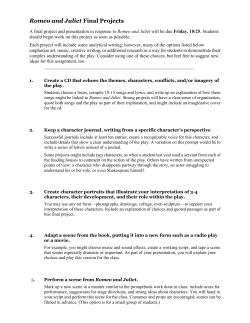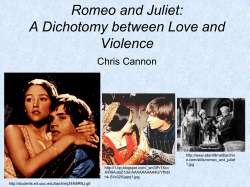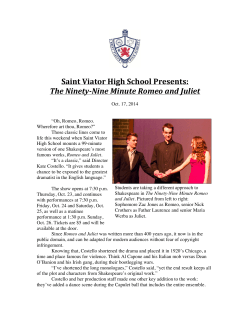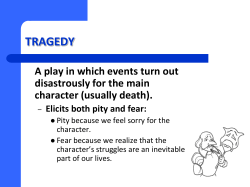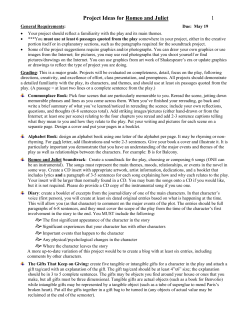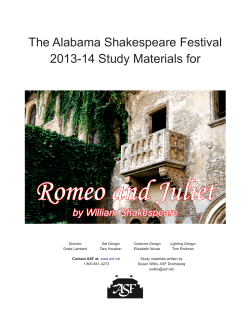
ASOLO REPERTORY THEATRE FSU/ASOLO CONSERVATORY FOR ACTOR TR AINING PRODUCTION ASOLO REP
A SO LO RE P EDUCATION & OUTREACH STU DY GU IDE 2013–2014 NEW STAGES TOUR A SO LO REPERTORY TH EATRE PRESENTS AN FSU/A SOLO CO NSERVATO RY FO R ACTO R TR AININ G PRO DU CTION by William Shakesp eare a d a p t e d by Laur yn E. S asso & Dmit r y Troyanovsk y dire c t e d by Dmit r y Troyanovsk y TOU RIN G SC HOOL S OCTOBER 1 - NOVEMBER 15, 2013 asolo rep leadership Producing Artistic Director Michael Donald Edwards Managing Director Linda DiGabriele FSU/Asolo Conservatory Director, Associate Director of Asolo Rep Greg Leaming romeo & juliet CASTS: in order of appearance Team Montague Benvolio/Capulet Tybalt, Nurse, Balthasar Montague, Mercutio, Friar Laurence, Apothecary Romeo romeo & Juliet creative team Juliet Director DMITRY TROYANOVSKY Adapted by LAURYN E. SASSO & DMITRY TROYANOVSKY Resident Dramaturg LAURYN E. SASSO Cale Haupert Maxey Whitehead Zlatomir Moldovanski Jefferson McDonald Lucy Lavely Team capulet Benvolio, Friar Laurence Tori Grace Hines Tybalt, Nurse, Balthasar Brian Nemiroff+ Montague, Mercutio, Apothecary Romeo Assistant to the Director daniel kelly Capulet Juliet Literary Apprentice Austen Anderson Reginald Robinson Ben Williamson Amanda lynn Mullen Kristen Lynne Blossom Costume Design June Elisabeth Taylor TABLE OF CONTENTS Sound Design MATTHEW PARKER o v e r v i e w..................................................... 2 Props Master Marlenn Marotte Whitney WHY romeo & Juliet ?.........................................3 E xplore the Adap tati o n: Char ac ters.............4 Voice & Dialect Coach PATRICIA DELOREY E xplore the Adap tati o n: Lan guage................5 Stage Managers Lauren Baston & Janell Williams Spe ak the Speech (Ia mbic Penta me ter)...........5 Stage Management Consultant Erin MacDonald Fight Director BRUCE LECURE asolo rep education & outreach staff Education & Outreach Director Kathryn Moroney Education & Outreach Specialist Tiffany Ford Education & Outreach Apprentice Kimberly Wiczer-Haupert + Appears courtesy of Actors’ Equity Association Love & Vi olence.................................................6 Passi o n o r O bsessi o n.....................................7 Fate & free will..................................................8 STUDY GUIDE HOW-TO Each discussion and activity has been selected to explore the content and themes of Romeo & Juliet. This guide may be used in its entirety or discussions and activities may be selected to enhance specific lessons. In this packet, there are activities for Theatre, Language Arts, and Social Studies classrooms. Activities correspond with Common Core Standards. Curriculum Key TH: Theatre SS: Social Studies LA: Language Arts VA: Visual Arts Study Guide Written by: Tiffany Ford and Kimberly Wiczer-Haupert P H OTOS BY daniel kelly and danica killelea EXTRA GOODIES When you see this logo, additional activities are available online at asolorep.org/education/resources. 3 overview You will be seeing an adaptation of Shakespeare’s Romeo & Juliet performed by actors in the FSU MFA Conservatory Acting Program. It is their 3rd and final year in this professional training program, housed at Asolo Repertory Theatre in Sarasota, FL. Director Dmitry Troyanovsky and Asolo Rep Literary Manager Lauryn E. Sasso have adapted the play with a fresh perspective to connect with a young, modern audience. This is a fastpaced version of Romeo & Juliet that sharply focuses on the journeys of the younger characters. You will experience the full story in 45 minutes of action, humor, and drama that maintains the integrity and depth of the original text. There will be a 15 minute post-show discussion (“talk-back”) after each performance during which the audience will be encouraged to ask the actors questions about the play, their characters, professional acting, and other elements of the production. Please equip your students to prepare talk-back questions. This study guide suggests important ideas, discussions, and activities that are consistent with the adaptation they will be seeing. It can be used for lessons leading up to the performance, and after the performance. Also included in the experience • 1 Opening Night comp ticket for each teacher who is bringing a class to see the performance at their school. Contact Tiffany_Ford@asolo.org. • Download the Opening Night program with extended essays from the artists. • Download additional Activity Descriptions at asolorep.org/education/resources. • Follow the casts on Facebook: www.facebook.com/randjteammontague and www.facebook.com/randjteamcapulet. why romeo & juliet? (LA,SS) Director (and co-adapter) Dmitry Troyanovsky explains why he feels Romeo & Juliet is a story relevant to audiences today: The first half of Shakespeare’s play runs as a slightly sardonic comedy about teenagers who are not overly graceful, nor especially idealistic. Sophisticated lovers or heroes these kids are not. But neither are they naïve victims of the cruel world of adults. Romeo and Juliet do what normal teenagers do: fall head over heels for each other. And they make choices that get them into trouble because the universe does not come with a set of guarantees. The fatal events, which give Romeo and Juliet their tragic halo, sneak up on the audience abruptly and heart-wrenchingly. Shakespeare masterfully shows us how two ordinary adolescents, surrounded by inept adults and hapless caregivers, can self-destruct due to a series of disastrous, if understandable, choices. There is no single, obvious explanation for what happens – what leads to the tragic end. This production won’t comfort us with a tidy lesson learned at the end. But it may show us we’re not alone when we deal with inexplicable loss. Maybe this play reminds us that we are all vulnerable — that we can’t always be protected, emotionally or physically.” DISCUSSION: • Is this play a tragedy? Why? What is your personal definition of tragedy? What is the classical definition of tragedy? What are some examples from real life that you consider tragic? • Why do you think tragedy encourages us to place blame or point fingers? Do you think there can always be a “lesson learned” from tragedy? Why or why not? 4 Explore the Adaptation: Characters (LA, TH, VA) M C montague family royal family capulet family lord & lady montague prince escalus Banished Romeo from Verona lord & lady capulet count paris Cousin to Prince Escalus Wishes to marry Juliet balthasar Servant Trusted friend romeo Son benvolio Cousin mercutio Best friend to Romeo Cousin to Royal Family Slain by Tybalt tybalt Cousin Slays Mercutio Slain by Romeo nurse Advisor Caretaker rosaline Loved by Romeo apothecary Sells poison to Romeo juliet Daughter = family friar laurence Romeo’s Advisor Marries Romeo & Juliet Creates Juliet’s death plan things to know & note = other connection DISCUSSION: In the original text, the character list includes over 30 characters. It is extremely AFTER THE PLAY: rare now, and was even rare in Shakespeare’s time, for a theatre company • What was your reaction to actors playing characters of different genders? How did this affect your perspective on the character or relationships? to use so many actors in a production. More often, actors play multiple roles. Directors may even choose to combine characters to simplify staging or casting. In Shakespeare’s time, female characters were most often played by male actors. In this adaptation of Romeo & Juliet certain roles will be played by the opposite gender actor from what you might expect. This character map separates the characters who are represented in this adaptation, and those who are only represented in the original text. THINK LIKE a Designer: • Look at the character map, and pick two characters. How would you represent a transition from one character to another using only one costume adjustment? Think like a costume designer, and consider the director’s choice of moderntime period, and the minimalistic requirements of a touring production. • What costume choices did you see that helped to portray the differences between characters played by the same actor? Did you notice vocal or physical choices the actors used for different characters? • What elements of the production demonstrated the separation between the families? 5 Explore the Adaptation: language (LA, SS) In this version of Romeo & Juliet, the co-adapters highlight and clarify what they agree are the important moments of the story. This means that some of the language has been altered, while still maintaining the rhythm of the text. While the dialogue in this version is not considered “modernized”, there are some grammatical updates that help to clarify the intent of the characters. Some lines were kept as the original text either because they are recognizable, or because of the intense emotion in that moment. • Example of altered text: Juliet: Dost thou Do you love me? • Example of unaltered text: Romeo: Deny thy father, and refuse thy name. DISCUSSION: • If you were adapting a version of your favorite Shakespeare play, would you choose to maintain or modernize the language? Why? speak the speech (iambic pantameter) (LA, TH) What makes Shakespearean plays sound so different than other plays? Did people really talk that way? Shakespeare and his contemporaries wrote in verse, a form of poetry used in playwriting to give the characters a structured speech pattern. Shakespeare wrote in a specific style of verse called iambic pentameter. What Is iambic pentameter? try it! A line in iambic pentameter has 10 syllables, five pairs of unstressed then stressed syllables. speak the quote Speak this quote from Romeo & Juliet aloud, and listen to the rhythm: The rhythm in each line of iambic pentameter sounds like: da-DUM / da-DUM / da-DUM / da-DUM / da-DUM Romeo: For example: this pie / looks good / enough / for me / to eat ! You’ll notice that the rhythm comes very close to the natural rhythm of the English language and 10 syllables is usually enough time to form a complete thought. solo ACTIVITY: listen for the rhythm Listen for a heartbeat rhythm as you watch the production. When do you notice this rhythm? When do you notice that this rhythm is broken? Consider the mood and action in each of these moments. But, soft! What light through yonder window breaks?* *Hint: If you are having trouble counting syllables, try drumming them out on your chest like a heartbeat as you speak the text aloud. Wait a Second! Juliet: O, bid me leap, rather than marry Paris, From off the battlements of yonder tower. These lines from Romeo & Juliet have 11 syllables in the wrong rhythm! This is an example of Shakespeare breaking from form, or breaking the rules. Shakespeare often did this to emphasize a character’s uncertainty, distress, or excitement. Love & Violence 6 (LA, TH, SS) Listen to how each of these characters speak about love. Notice how much violent language and imagery Shakespeare uses. Director and Co-adapter, Dmitry Troyanovsky, observes: “Love, it turns out, may be just as perilous as hatred.” MERCUTIO: (referring to Romeo’s state of mind since his relationship with Rosaline has ended) Alas poor Romeo! he is already dead; stabbed with a white wench’s black eye; shot through the ear with a love-song; and is he a man to encounter Tybalt? TYBALT: (realizing that an enemy is at his family’s party) This, by his voice, should be a Montague. What, dares the slave come hither? Now, by the stock and honor of my kin, To strike him dead, I hold it not a sin. ROMEO: (asking Mercutio to empathize with his broken heart) Is love a tender thing? it is too rough, Too rude, too boisterous, and it pricks like thorn. CAPULET: (ordering Juliet to marry Paris) Disobedient wretch! I tell you what: get you to church o’ Thursday, Or never after look me in the face: Speak not, reply not, do not answer me; My fingers itch. If you be mine, I’ll give you to my friend; And you be not, hang, beg, starve, die in the streets, For, by my soul, I’ll ne’er acknowledge thee. Juliet: (realizing that Romeo is banished) I’ll to the friar, to know his remedy: If all else fails, myself have power to die. Discussion: • Can you tell why each character uses violent images? Who do you suspect will take violent action? • Do you agree that love can be as dangerous as hate? Why or why not? What are some examples you see in real life? solo activity: Choose one of the below scenarios, and write a letter from that character’s perspective. Consider what they might feel, and how they might react to the situation. 1. As he is dying, Mercutio says “A plague o’ both your houses.” What do you think he is trying to say in this moment? Write a letter expressing what you think Mercutio would say if he had the chance to speak to both families before his death. 2. How might Tybalt react if he were to see Romeo speaking to Juliet at the Capulet’s party? Is there something specific he would want to say to Juliet if he had the chance? Write a letter to Juliet from his perspective. 3. Consider how Juliet might feel when she discovers that Romeo killed Tybalt. Consider how Romeo feels when he realizes what he’s done. Choose to write a letter either as Romeo to Juliet, or as Juliet to Romeo, that expresses what he/she would want to say to the other in this moment. Going Further: • Why do you think the young people in Romeo & Juliet are taking action without consulting their families? When do you act alone, and when do you seek guidance? • How do the choices and opinions of the adults around you affect your choices? passion or obsession? (LA, TH, SS) Co-adapter Lauryn E. Sasso explains her take on the instincts of the characters in the play: “The hyperbole and passionate actions and language in Romeo & Juliet call to mind the way we speak today in social media – reactive, dramatic, often jarring, and sometimes borderline disturbing.” pre show discussion: • How would you define passion? How would you define obsession? What is the difference? • Consider the way you use social media to comm- unicate and express your passions. How do you choose what you keep private versus what you choose to share? post show discussion: • Which characters’ passions became obsessions or showed signs of obsession? How could you tell? • When is obsession helpful? When is it harmful? Think of examples from Romeo & Juliet, your own life, history, and current events. Solo ACTIVITY: in the eyes of the characters Pick a character you relate to from Romeo & Juliet, and consider how they see themselves. What specific topics or issues are they passionate about? Do they have an obsession? Using one blank page, craft what you think their Facebook page or Tumblr would look like. Make choices about the topics they would post, the language they would use, and who they would communicate with via social media. Feel free to create imaginary images and comments/discussions. Variation: Assign pairs to complete this project as a team. Ask teams to present their work to the class. 7 fate & free will Actor Six: From forth the fatal loins of these two foes, A pair of Star-cross’d lovers take their life… 8 (LA) JULIET: O, swear not by the moon, the inconstant moon, That monthly changes in her circled orb, Lest that your love prove likewise variable. Romeo: O, I am fortune’s fool! Romeo: I fear, too early: for my mind misgives Some consequence yet hanging in the stars Shall bitterly begin his fearful date With this night’s revels discussion: • Do you believe in fate? Why or why not? • Do you think Romeo & Juliet communicates a message or perspective about fate? • Why do you think fate or destiny is still such an intriguing and controversial topic today? NEW STAGES FOUNDATION & INDIVIDUAL SPONSORS The award-winning New Stages tour is sponsored in part by: Charles Henry Leach II Foundation; Asolo Repertory Theatre Guild; Cordelia Lee Beattie Foundation; Mandell and Madeleine Berman Foundation; Linnie E. Dalbeck Memorial Foundation Trust; Andrew R. Ferrell Foundation; Harold C. and Jacqueline F. Bladel Foundation; Plantation Community Foundation Major individ ual support provided by: Anonymous, David and Betty-Jean Bavar, Lisa Carlton, Carole Crosby, Ruby E. and Carole Crosby Family Foundation, Susan Dweck, Bill and Christine Isaac Additional Support provided by Bob and Pat Baer, Bob and Beverly Bartner, Deborah and Walton Beacham, Len and Judy Brown, Christine and John Currie, Wendy and Jerry Feinstein, Debbie and Larry Haspel, Steve and Maureen Horn, Lynne and Robert Huff, Allen Jelks, Jack Kesler and Maurice Richards, Carolyn Keystone and Jim Meekison, George Kole and Judy Zuckerburg, Beverly L. Koski, Ashley Kozel, Terrance McKee, Melanie and Sean Natarajan, Jill and Scott Ramsey, Skip and Gail Sack, Ted and Mary Ann Simon facebook.com/AsoloRepEDU VISIT US ONLINE AT twitter.com/AsoloRepEDU ASOLOREP.ORG youtube.com/AsoloRep
© Copyright 2025
